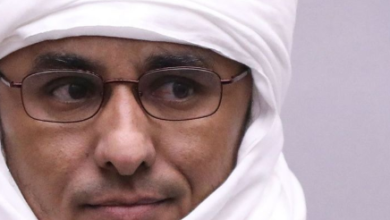Boko Haram: How Ngarannam community attacked by terror group was rebuilt

Ngarannam, Nigeria
CNN
—
It is a sight Ya Lewa Aji says she can never forget: a baby strapped to her mother’s back, shot dead while the mother lay lifeless on the floor.
But she barely had time to take in the scenes of horror unfolding before her as she and her family fled for their lives.
It was the night in 2015 that Boko Haram militants attacked Ngarannam town in Borno State, northeast Nigeria.
They arrived in the dead of night with guns and machetes and attacked indiscriminately.
“We were sleeping and heard screaming and gunshots. We ran for our lives. We lost everything. The gold I was given on my marriage day. Our farm items, goats and cows,” Aji told CNN.
“We thank God we did not lose any children, but I will never forget seeing a little baby shot dead on her mother’s back. Her mother was also dead,” she recalled.
Since 2009, the armed Islamist group Boko Haram has waged an insurgency that has displaced more than two million people in the country’s northeast, according to the UN.
Ngarannam, a village of around 3,000 people, became desolate after the attack as displaced residents fled to Borno’s capital Maiduguri and surrounding areas.
Now, after nearly a decade living in refugee camps, Aji has returned to the land of her birth with her husband, his two other wives and some of their 19 children.
They are part of the first wave of Ngarannam residents who are moving back in a joint rebuilding project between the Borno State government, the United Nations and the European Union.
Amid fanfare and celebrations, the residents returned to the town last Saturday.
Under the blazing 38C heat, excited residents gathered to gain access to their new homes. On the walls of the building was a picture of each homeowner, saying “Welcome home.”

“I take this opportunity to state clearly that we are not under any illusion that our job is done, there is still more to be done. There are more communities to be rebuilt, more infrastructure to be provided and stronger system of government to be instituted to serve our people,” Governor Babagana Umara Zulum said as he declared the settlement open.
The village has been reconstructed with a primary school, teachers’ quarters, a police outpost and residence, and solar powered water facilities, according to the UNDP.
It is a bittersweet return for Aji and her family, however. Her husband Bulama is the community leader for Ngarannam, which afforded them a certain privilege in the town.

Aji is the first of his three wives and where once they had a homestead with 9 bedrooms and plenty of land, they are now forced to make do with a 2-bedroom house allocated to them through the scheme.
Still, he says they are grateful to have a roof over their heads after years in makeshift tents.
“I thank God and the people who helped us. After nearly 10 years I am back in my land. Nothing is better than to be in the land I was raised up.”
The Rebuilding Ngarannam project is part of a hearts-and-minds stabilization program in the northeast, the region worst affected by the insurgency.
It provides new and dignified living spaces to resettle people internally displaced by Boko Haram.
The regional government announced plans in January to close IDP camps and resettle displaced persons by the end of the year.

At the time Governor Zulum said the camps had become overrun with vices such as “prostitution, drugs and thuggery.”
“The IDPs are tired of life in the camps. They complain to us day and night about their plight. They do not have food, and their children are being exploited. They need to return to their homes,” he added in a March interview.
Ngarannam will receive 804 houses in total as part of the partnership with the United Nations Development Programme and the Borno State Government, (UNDP) according to a spokesperson for the agency.
The government has planned 304 houses in total, while the UN agency is building a further 500, 360 of which were unveiled on Saturday.
Similar rebuilding is planned across the worst-affected parts of the northeast, the UNDP said.
The project was conceived and led by Mohamed Yahaya, the UNDP’s Resident Representative for Nigeria.
“We have done a lot of resettlement projects but we wanted to do something different. This specific town was chosen as a prototype in bringing design for internally displaced people… we were lucky to find a brilliant young Nigerian architect to lead the project. I’m really proud that we didn’t have low expectations of the poor and people who have been displaced. Design is a real feature of the way the units were built,” Yahaya said.
Lead architect Tosin Oshinowo also had consultations with the community before building commenced she told CNN.
“I really wanted to understand what their wants and their needs were, and to involve them in the process. So, I produced a concept … I presented it to them… just to carry them along and explain to them what the compounds will be like how many units will be in them …,” she said.

The buildings are inspired by the Islamic lifestyle and culture and the security of the residents was taken into consideration in the design.
“We also have the layout of the overall site with breaks between so that we never have a clean line of sight. So for security reasons, if there’s ever any insurgency attack, you don’t have people running in a straight line and they become effectively a target,” Oshinowo, who runs design firm cmDesign Atelier in Lagos, said.
Construction began in August 2021 and the homes are being handed over just over a year later.
“I’m really proud to be involved in this project. And I’m really hopeful that we’ve created spaces where, who knows who could grow up here, and what great things they will do. So you know, for me, this is really about legacy,” Oshinowo said.
For some residents, these security fears persist, and Boko Haram has not entirely gone away.
“We are not expecting anything bad to happen, but it would be good to have more soldiers posted in the community so we can rely on them and feel free to do our work and live peacefully,” Hajja Fulata, a local who is moving back, told Reuters.
It is a reality Yahaya acknowledges.
“Boko Haram are still here and one of the ways this program contributes to defeating the insurgency is … you have to look at what caused the insurgency, the root cause of the insurgency. For us the root cause of the insurgency is the lack of development,” he said.
Source link





